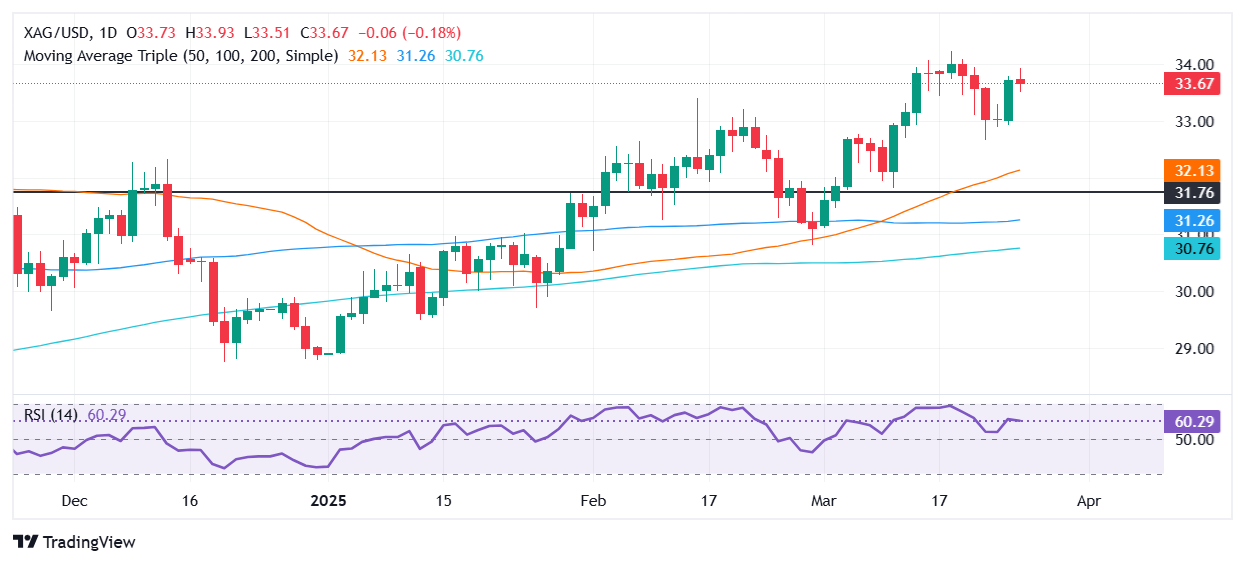Silver Price Forecast: XAG/USD retreats from 4-day peak, beneath $34
- Silver retreats 0.32% after hitting $33.92, pressured by US Dollar rebound despite recent bullish momentum.
- RSI suggests bulls may attempt another push above $34.00 toward key resistance at $34.86.
- Breakdown below $33.00 exposes support at $32.66, followed by 50-day SMA near $32.04.
Silver price retreats by 0.32% after reaching a four-day high of $33.92. At the time of writing, XAG/USD trades at $33.60, undermined by the strength of the US Dollar, which has registered solid gains.
XAG/USD Price Forecast: Technical outlook
After registering a solid rally on Tuesday, Silver failed to break the $34.00 mark, which opened the door for sellers, capping the grey metal’s advance to challenging yearly peaks, near $34.23.
Momentum favors XAG/USD upside as depicted by the Relative Strength Index (RSI), which, is about to surpass the previous peak. Therefore, short-term further upside is seen.
XAG/USD first resistance would be the March 26 high at $33.92. Once cleared the next stop would be the $34.00 figure, followed by last October’s monthly peak at $34.86.
Conversely, if XAG/USD slips beneath $33.00, immediate support emerges at the March 21 low of $32.66. Once hurdled, the next stop is the 50-day Simple Moving Average (SMA) at $32.04.
XAG/USD Price Chart – Daily

Silver FAQs
Silver is a precious metal highly traded among investors. It has been historically used as a store of value and a medium of exchange. Although less popular than Gold, traders may turn to Silver to diversify their investment portfolio, for its intrinsic value or as a potential hedge during high-inflation periods. Investors can buy physical Silver, in coins or in bars, or trade it through vehicles such as Exchange Traded Funds, which track its price on international markets.
Silver prices can move due to a wide range of factors. Geopolitical instability or fears of a deep recession can make Silver price escalate due to its safe-haven status, although to a lesser extent than Gold's. As a yieldless asset, Silver tends to rise with lower interest rates. Its moves also depend on how the US Dollar (USD) behaves as the asset is priced in dollars (XAG/USD). A strong Dollar tends to keep the price of Silver at bay, whereas a weaker Dollar is likely to propel prices up. Other factors such as investment demand, mining supply – Silver is much more abundant than Gold – and recycling rates can also affect prices.
Silver is widely used in industry, particularly in sectors such as electronics or solar energy, as it has one of the highest electric conductivity of all metals – more than Copper and Gold. A surge in demand can increase prices, while a decline tends to lower them. Dynamics in the US, Chinese and Indian economies can also contribute to price swings: for the US and particularly China, their big industrial sectors use Silver in various processes; in India, consumers’ demand for the precious metal for jewellery also plays a key role in setting prices.
Silver prices tend to follow Gold's moves. When Gold prices rise, Silver typically follows suit, as their status as safe-haven assets is similar. The Gold/Silver ratio, which shows the number of ounces of Silver needed to equal the value of one ounce of Gold, may help to determine the relative valuation between both metals. Some investors may consider a high ratio as an indicator that Silver is undervalued, or Gold is overvalued. On the contrary, a low ratio might suggest that Gold is undervalued relative to Silver.

